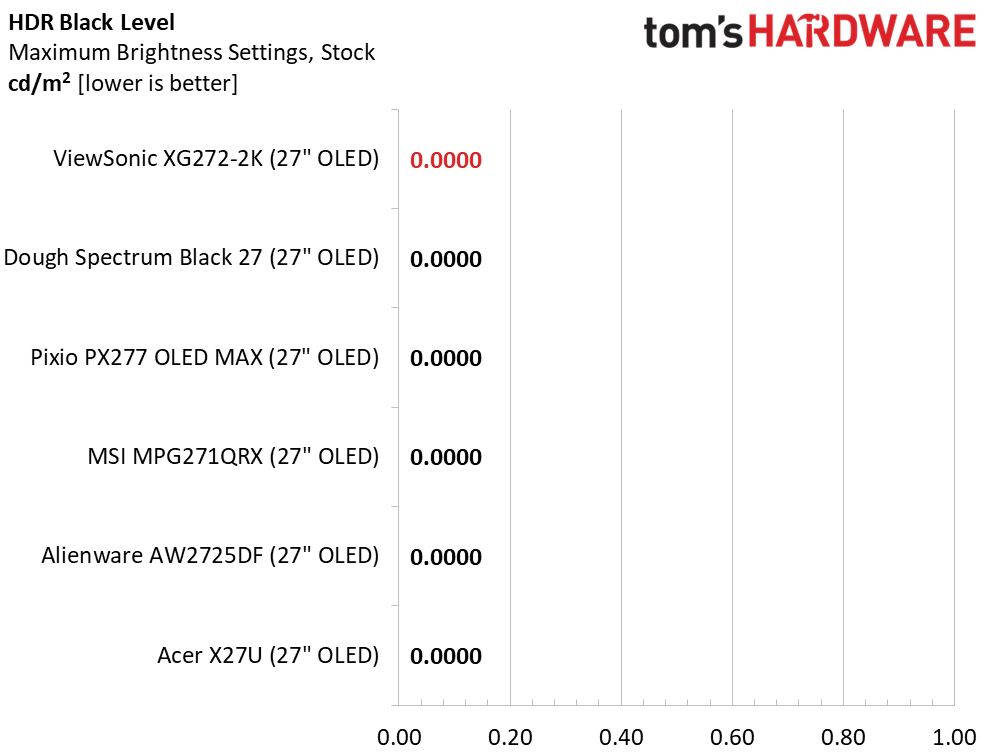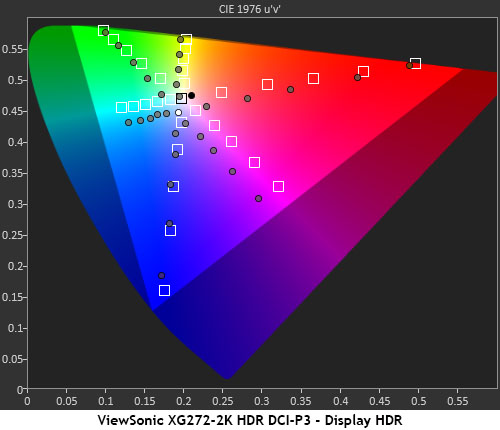Why you can trust Tom's Hardware
Our HDR benchmarking uses Portrait Displays’ Calman software. To learn about our HDR testing, see our breakdown of how we test PC monitors.
The XG272-2K supports HDR10 content by switching automatically to HDR mode. There are three picture presets which look very similar to one another. DisplayHDR delivers the best accuracy, and by happy coincidence, it’s the default choice.
HDR Brightness and Contrast



The XG272-2K surprised me by topping 931 nits when measuring a 25% window pattern in HDR mode. This makes it the brightest 27-inch QHD OLED I’ve tested. The Alienware and MSI screens are more typical of the category, peaking at around 450 nits. ViewSonic doesn’t advertise any VESA certification, but my sample certainly comes close to the magic 1,000-nit mark. As usual for an OLED monitor, black levels and contrast cannot be determined. This is excellent performance.
Grayscale, EOTF and Color



This part of the XG272-2K’s HDR tests disappointed me. The grayscale is visibly blue in tone, with errors showing throughout the brightness range. The tint can be seen in content as well. Though there is plenty of contrast, the picture isn’t as vibrant as it could be. High brightness mitigates the issue a little, but there is room for improvement. The EOTF tracks a bit light from 10% brightness to the tone-map transition at 60%. This makes shadow detail very visible but not quite as black as it should be.
The grayscale issues manifest in the gamut test by pulling some colors off their hue targets. Green, blue, and yellow are closest to the mark and have no visible problems. But red, magenta, and cyan are wide of their reference points. The same behavior can be seen in both DCI-P3 and Rec.2020 mastered content.
Test Takeaway: The XG272-2K has very bright HDR, brighter than its competition. But with visible grayscale and color errors, and a light luminance curve, the picture doesn’t have the extra vibrance that it should. Its HDR is satisfying but not as much so as other screens in its class.
MORE: Best Gaming Monitors
Get Tom's Hardware's best news and in-depth reviews, straight to your inbox.
MORE: How We Test PC Monitors
MORE: How to Buy a PC Monitor

Christian Eberle is a Contributing Editor for Tom's Hardware US. He's a veteran reviewer of A/V equipment, specializing in monitors. Christian began his obsession with tech when he built his first PC in 1991, a 286 running DOS 3.0 at a blazing 12MHz. In 2006, he undertook training from the Imaging Science Foundation in video calibration and testing and thus started a passion for precise imaging that persists to this day. He is also a professional musician with a degree from the New England Conservatory as a classical bassoonist which he used to good effect as a performer with the West Point Army Band from 1987 to 2013. He enjoys watching movies and listening to high-end audio in his custom-built home theater and can be seen riding trails near his home on a race-ready ICE VTX recumbent trike. Christian enjoys the endless summer in Florida where he lives with his wife and Chihuahua and plays with orchestras around the state.
